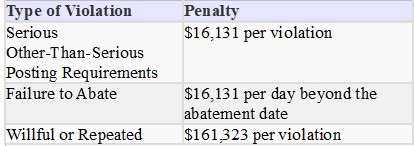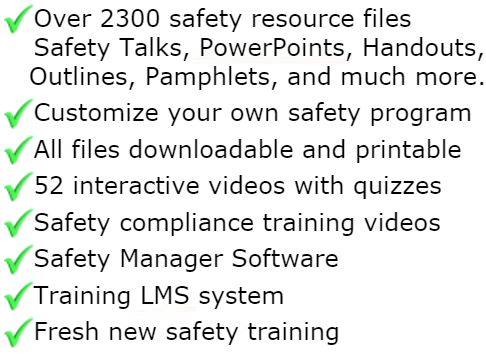
Fleet Vehicle Safety & Driver Safety
Defensive Driving
RIGHT-OF-WAY - Generally the driver who arrives last gives right-of-way to those who were already there. You give right-of-way when entering traffic. You give right-of-way when turning left in front of approaching traffic. You give right-of-way when changing lanes. You move into your intended path or direction only after you are assured you will not conflict with other traffic.
START-UP/BACK-UP - During a typical start-up/back-up situation, a vehicle has been parked for a long enough time to allow pedestrians and other vehicles to approach and rest within a few feet of the parked vehicle. Starting up forward, backward, or steering left or right from a stopped position can create an unexpected hazard for both the driver and bystanders.
NEGOTIATING CURVES - When negotiating a curve at an excessive speed, commercial motor vehicles will roll over. Automobiles will lose traction and slide out of a curve instead of rolling over. The more top-heavy a vehicle is, the more likely it will roll over than slide out of a curve. During a tractor-trailer rollover, the trailer usually begins to roll before the tractor. By the time the driver realizes that the trailer is rolling, there is not much that can be done to prevent a complete rollover.
PASSING - Safe passing maneuvers require well developed skills and judgment. Passing tasks include checking sight distance ahead, checking mirrors for rear traffic, checking for traffic passing you, estimating speed and position of approaching vehicles; estimating time you need to safely pass, accelerating, steering, checking for traffic entering from side roads, etc. Because the driver must perform several tasks in a short time during passing, the chance of an error is high, unless the maneuver is done cautiously. Because it sometimes takes a long time before an opportunity to pass safely arises, some drivers take risks and assume other drivers will compensate for their own aggressiveness.
TURNING LEFT AND RIGHT - Making left or right turns with long vehicles creates problems that automobile drivers do not have. Blind spots make it difficult to see other vehicles. Vehicle length forces drivers to make wide turns, encroaching upon adjacent lanes of traffic. Improper tracking of vehicles makes it difficult for the driver to judge position. Turning takes longer to complete, thus increasing exposure time to hazards. Drivers should recognize the hazards created while turning and follow proper procedures to minimize them.
CROSSING INTERSECTIONS - Crossing intersections with long vehicles presents problems that automobile drivers do not have. Because of their length and their slow acceleration, trucks and buses take much more time to cross and clear intersecting roads than do automobiles. Also, at night, the sides of long vehicles may not be conspicuous to approaching drivers. Drivers of large vehicles must recognize these problems and take special care when crossing intersections, particularly when they are uncontrolled intersections.
USING AND CHANGING LANES - Lane use and lane changing accidents primarily result from following too closely or being inattentive to traffic conditions ahead. In either case, defensive driving is the most effective countermeasure. Lane use and lane changing accidents primarily involve sideswiping and rear-end collisions. The existence of blind spots around large vehicles is a major contributing factor. Maintain a proper following distance and take note of countermeasures involving right-of-way.
PARKING - Parking on or partially on a travel lane creates a hazard. This is especially true at night. On congested metropolitan streets, drivers expect to see parked vehicles in their lane and are usually ready to react and avoid them. On rural and high-speed roads, drivers do not expect to see vehicles parked in their lane. Their attention level may be lower and they may not be able to react quickly enough to avoid a collision.
NEGOTIATING DOWNGRADES - The main reason for loss of control on downgrades is brake failure, and the main reason for this is the use of improper control techniques by the driver. The brake system may be damaged or maladjusted and may not have sufficient capacity for downgrade control. Primary countermeasures for preventing a runaway are: adequate driver skills; frequent checks on brake operation; adequate preventive maintenance.
DRIVING IN ADVERSE CONDITIONS - Failure to adjust to adverse conditions is a major factor in accident causation. The adverse conditions most frequently encountered cause reduced traction and reduced visibility. Reduced traction conditions include rain, snow, ice, slush and gravel. Reduced visibility conditions include twilight, darkness, rain, snow and fog. Drivers should not only develop the skills and judgment necessary to keep their own vehicle safely under control, they should also try to anticipate and be prepared to compensate for errors other drivers make during such poor driving conditions.
EMERGENCY EQUIPMENT AND PROCEDURES - Emergency situations include stalling in a travel lane, stopping for an accident in your path, engine compartment fire, wheel fire, burned-out light bulbs, blown fuse in lighting circuit, etc. Having emergency equipment available in your vehicle and knowing how to use it will greatly assist you in avoiding hazards that arise in these types of situations.
PEDESTRIAN INTERACTION - Most pedestrian accidents occur when the pedestrian walks onto a roadway and into the path of an approaching vehicle. Pedestrians often misjudge the speed and closeness of a commercial motor vehicle. Pedestrians assume you can and will slow down for them. Pedestrians think that because they can see you, you can see them. These kinds of errors in judgment are why pedestrian accidents frequently occur. Drivers should try to anticipate pedestrians making such errors and be prepared to compensate.
PASSENGER MANAGEMENT - Passengers can distract the driver. Passengers can physically interfere with the driver. Passengers can restrict the driver's freedom to maneuver aggressively for accident avoidance. Passengers can injure themselves by not sitting properly in designated seating positions. Whatever the case, the driver must manage the passengers to avoid such problems.
PREVENTABLE VEHICLE ACCIDENTS
A preventable vehicle accident is one which occurs because the driver fails to act in a reasonably expected manner to prevent it. In judging whether the driver's actions were reasonable, one seeks to determine whether the driver drove defensively and demonstrated an acceptable level of skill and knowledge. The judgment of what is reasonable can be based on a company-adopted definition, establishing a goal for the vehicle safety management programs. The great majority of preventable vehicle accidents can be shown to be directly related to the performance of the driver. It is therefore extremely productive to any fleet safety program to have a careful new driver selection and adequate monitoring procedures for existing drivers.
Safe driving recognition or incentive programs should be an integral part of a formal fleet safety program. Such programs identify superior driving performance and set forth the selected drivers as examples to be emulated by the rest of the fleet. Such programs can be generated internally within the company or through participation in national safe driver award programs conducted by associations such as the National Safety Council or the American Trucking Associations.
Driving is a profession requiring skill, knowledge, physical and mental health and character integrity. Public safety and company reputation requires that drivers be fully qualified. Drivers who are not qualified should receive remedial training or be terminated if they cannot be brought up to the necessary level of competence.
It has been well documented that drivers under the influence of alcohol or drugs have been involved in about half of all fatal traffic accidents. Drinking or substance abuse by drivers of alcohol or drugs cannot be tolerated. Company management must be acutely aware of the seriousness of this societal problem and establish procedures to effectively control it within their respective organizations.
Everyone understands how ill or fatigued drivers can be a hazard to themselves and others. Nonetheless, drivers sometimes push their bodies beyond reasonable limits and become a hazard anyway. This is why comprehensive federal regulations have been established. In addition to being law, these regulations are useful guides to both the driver and his supervisors in defining reasonable, sensible limitations on when medical conditions or duty status calls for rest and no driving.
Fleet safe driving performance is dependent on management commitment to the implementation of a formal fleet safety program. An effective safety program will interact with most aspects of fleet operations and challenge the skills and knowledge of its supervisors and drivers.
The company driver manual is a key communication link between the company and its drivers. It conveniently brings together information about the company, its policies and procedures. It is indispensable for training new drivers and is a handy reference for existing drivers. The manual should be progressively developed and continually updated.
All materials in the members area for this topic index

GET INSTANT ACCESS
to THE MEMBERS LIBRARY
Safety materials created by safety professionals.
Access to the Safety Manager software.
Wide variety of safety videos and courses.
**Brand New** Safety Training Management System
Pre-Made Safety Materials Ready For Use
Created by experienced safety professionals & risk consultants. Saving you time, money, and risk of injuries.
95% of the work already done.
Below are the maximum penalty amounts, with the annual adjustment for inflation, that may be assessed after Jan. 15, 2024. (See OSHA Memo, Jan. 8, 2024).

**New OSHA HEAT 90 DAY**
>>Download Free HERE<<
**New 2024 OSHA 300 Form**
>>Download Free HERE<<
**Brand New**
Free with full membership subscription
Training LMS System
Ask The Safety Consultant
Safety Equipment Deal Finder

“SafetyInfo.com is the first go-to website for safety professionals and companies to use in establishing a solid safety program"
-Mike McKenzie, Certified Safety & Health Manager (CSHM), McSafety Solutions™
Note: You must have a full subscription to the Safety Library in order to use this material. Any use outside of your organization, for resell, or without an active membership is strictly prohibited and may result in prosecution under copyright infringement laws. Please contact us first, if you would be interested in reselling or using our materials for reproduction.
Inside the Members Library
Topic Index
Accident Prevention
Air Quality
Asbestos
Bloodborne Pathogens
Boilers
Chemical Safety
Compressed Gas
Confined Space
Construction
Construction Worksite
Cranes & Slings
Driver / Fleet Safety
Drug Free Workplace
Electrical
Emergency Management
Engineering Safety
Environmental
Equipment
Ergonomics
Fall Protection
Fire Safety & Prevention
First Aid
Flammable Materials
Forklifts
Hazard Communication
Hazardous Materials
Hearing Protection
Heat Stress
Hot Work
Housekeeping
Job Safety Analysis
Laboratory
Ladders
Lead
Lockout-Tagout
Machinery & Equipment
Material Handling
MSDS (SDS)
Medical & First Aid
Occupational Health
Office Safety
Off the Job Safety
Personal Protection
Process Safety
Record Keeping
Respiratory Protection
Silica Safety
Rules & Policies
Signs & Labels
Slips, Trips & Fall
Training
Terrorism Programs
Tool Safety
Vehicle & Driver
Violence Programs
Welding & Hot Work
Training Videos
Library Index
Training Materials
Videos/Courses
Talks
Articles
PowerPoint
Handouts
Training Overheads
Quizzes
Supervisor Briefs
Management Briefs
Safety Sessions
2 Minute OSHA Safety Talks
Pamphlets
First Aid Training
Supervisor Training
Hazardous Materials
Bomb Threat
Crossword Puzzles
Biological Agents
Forms & Documents
Forms
Checklists
Audit Guides
Inspections Guides
Signs & Labels
Environmental Audit Guides
Recordkeeping - OSHA 300
Sign & Label Maker
Safety Management Resources
Safety Manuals/Written Programs
Ergonomic Programs
Emergency Plans
Process Safety Management
Construction Safety
Occupational Health
Environmental
Topic Sheets
DOT Fleet-Driver
Hazardous Materials
Chemical Safety
Drug Free Workplace
Terrorism Programs
Development Guides
Safety Manager Software
Safety References & Graphics
Technical Safety Information
Posters
Topic & Fact Sheets
Development Information
Job Specific Safety Rules
Terrorism
Calculators
Safety Comic Strips
New Safety Training System
Schedule and train your employees with our materials. Add unlimited amount of employees. Record all progress and issue certificates. For group and individual training sessions.

